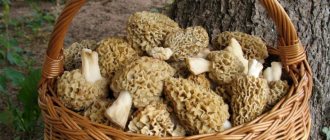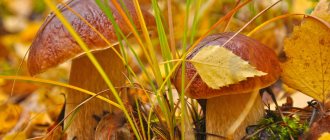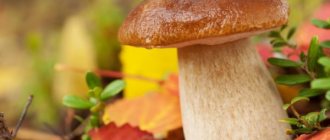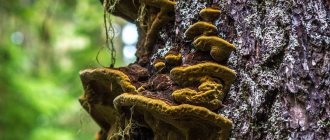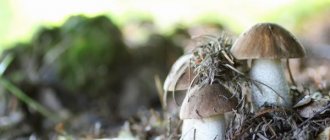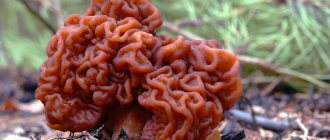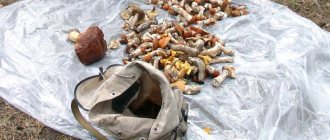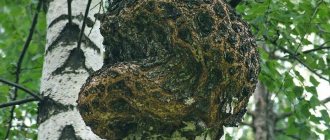It just so happens that humanity loves “quiet hunting” for mushrooms. In our latitudes they appear in mid-summer and delight us until the end of autumn. But not all mushrooms can be eaten. Some are generally poisonous and cause serious consequences, and even death. To avoid accidents, you need to know the main differences between regular and false mushrooms.
All wild mushrooms are divided into: edible, conditionally edible (or inedible) and poisonous
- Edible mushrooms are used in culinary recipes around the world and add their own flavor to every dish.
- Conditionally edible mushrooms, after prolonged heat treatment, will not cause harm to health. These include milk mushrooms, morels and autumn honey mushrooms. They should be cooked for at least 40 minutes and then rinsed well.
- Poisonous ones are gall mushroom or mustard mushroom, devil's or satanic mushroom, false puffball and others.
Very often, when hunting for mushrooms, we come across those that mislead us. Therefore, it is vitally important to know the distinguishing characteristics of edible and especially poisonous mushrooms.
Pear-shaped, hedgehog or hedgehog-spiny puffball and its double, false puffball
The body of the mushroom is pear-shaped, which is why it got one of its names. The “pseudo leg” is clearly defined, but sometimes it is hidden under the moss, making the mushroom appear round.
A young raincoat is almost white, but over time it undergoes a certain metamorphosis, and it changes color to dirty brown. The surface is covered with ring-shaped dense spines. A large spike sticks out in the center of each ring, and small needles on its sides. If you step on a ripe puffball, it will burst into a “smoke” of spores.
The correct raincoat is hard to the touch, and when cut open it is white as milk.
The pear-shaped puffball is considered edible only until its flesh begins to darken.
In medieval Europe, raincoats were used to make broths for sick people. Already at that time their enormous benefits for the body were known.
False raincoat
Instead of thorns, it is covered with warts, has an elongated fruiting body and a nasty smell. The mushroom is conditionally edible and can even be dangerous if eaten in large quantities.
How to identify poison during cooking
The composition of toxins is not the same in different types of mushrooms, as is their effect on the body, so there is no universal way to identify poisonous varieties during cooking.
You can use the following folk methods to control the content of poisons in the pulp:
- Onion or garlic
During the first cooking, place a peeled onion or several cloves of garlic into the pan. If there is tyrosine in the water, the vegetables will turn brown.
- Milk
Under the influence of the poisonous enzyme pepsin, milk curdles.
Therefore, to test, mushrooms are placed in the liquid. However, some edible species contain a certain amount of pepsin, so the method cannot be considered reliable. When cooking mushrooms, do you determine the poison content in it?
Always Now I will
White mushroom and its doubles
The porcini mushroom is exquisite, fleshy, with an exquisite taste; finding such a mushroom is a real success for lovers of quiet hunting. It is extremely rich in useful elements, and it is very rare to find it. It has a brownish head, the color of which varies from light hazel to dark brown. After rain it is quite slippery, but in dry weather it is dry and velvety.
Small specimens are almost round, with a cap that is rolled up at the edges; as they grow older, it opens up and becomes almost flat. Compared to the head, the leg is powerful, fleshy, barrel-shaped with a convexity in the middle. The color of the leg is almost white or pale brown, the surface of the mesh structure is beige. The pulp is white, tight and elastic, but with age it acquires a slightly spongy structure. After cutting, the color remains the same.
Bile mushroom
At first glance, it is quite difficult, almost impossible, to immediately understand that it was the bitterweed that got into the basket. It is very reminiscent of the correct porcini mushroom. But a thin mesh on a dark-colored stalk and a spongy cap on the underside indicate an erroneous mushroom. Its flesh also quickly turns red at the break, and the cap has a pinkish tint.
The cap is spongy with a thin layer of porous pulp.
Biologists consider the gall fungus to be inedible. If you lick it, bitterness immediately appears, and heat treatment only intensifies it. But in a vinegar marinade, the bitterness is partially masked by vinegar, and if you soak it in water for a long time, it will disappear completely. Therefore, some mushroom pickers do not exclude this mushroom from their diet.
Satanic mushroom
This false boletus stands out for its truly colossal size: its cap can reach 40 cm, and its leg - 15 cm. It looks so elegant and festive, it is unlikely that anyone will confuse it with a porcini mushroom.
A distinctive feature is a hat with a top that looks like a pillow. Under the cap there is a dense sponge of a light pink color. The surface of the mushroom is slightly rough to the touch.
The main sign is that after cutting the stem, you can observe first a blue and then a bright red color. Satanic mushroom smells like a rotten onion. Unfortunately, only adult specimens have this feature, and the young mushroom does not smell at all, which leads to confusion. 10 g of raw false boletus is enough, after which a person can experience complete paralysis of the nervous system.
Peppery
The caps are about 2-7 cm, the stem is thin, about 3-8 cm high. Among mushroom pickers there is often a debate about its toxicity, but scientists have proven that the mushroom is poisonous; it just has a very long-lasting poison effect.
It does not begin to act immediately, but is capable of accumulating in the human body and gradually destroying the liver. Most often it grows in various coniferous forests.
Real honey fungus and its doubles
True honey fungus grows in large families on the stumps and rhizomes of trees. The cap is round, light brown, with small copper scales. In older mushrooms it is light, but over time it becomes brownish.
The stem of the mushroom is thin, flexible, elongated, hollow inside and “dressed up” in a ring-skirt. The pulp is soft, moist, pale beige in color, pleasant to the taste, with a distinct aroma of wood.
Sulfur-yellow false honey fungus
It is similar to the edible one, but smaller in size. The leg is thinner and does not have a film under the head. The head is round and flat, grayish-yellow, slightly darker in the center. If you break it, you can see blue juice that smells and tastes bad. The sulfur-yellow honey fungus is not lethally poisonous. However, the outcome is also unpleasant: taking it causes a spasm and not fatal, but still poisoning.
False honey mushrooms brick-red
These representatives of the fungal fauna have a fleshy, brick-red, poisonous-brown or yellow-brown cap. You can see nice white flakes on its edges. The leg is long and thin, there is no dense ring of film on it. The base of the leg is dirty brown, it is tight, straight or narrowed towards the bottom.
Application
The medicines that we use are prepared not only from edible, but also from poisonous or conditionally edible mushrooms.
Inedible white twins are successfully used for bactericidal preparations and ointments for frostbite. They contain substances that help fight staphylococcus and cancer.
An extract from the beautiful boletus is used to treat typhoid, paratyphoid and purulent skin lesions.
Porcini mushroom counterparts contain large amounts of psilocybin and alkaloids in their pulp. These substances actively affect the brain of a mentally ill person and normalize its activity.
Boletus and their doubles
With these mushrooms everything is much simpler; it is very difficult to confuse them. The color of the oiler head can range from chestnut to bluish-green or yellow-brown. Not an old mushroom looks like a ball crawling out of the ground. The sticky, slippery skin peels away from the flesh well.
The stem is slightly lighter than the cap, often with a dirty tint. It can be solid or fibrous and cylindrical. The pulp is fresh, brown at the root and light yellow near the cap, brown just under the cap. Butterflies are often attacked by worms and other pests.
Pepper mushroom
Pepper mushroom is very poisonous. The poison settles in the liver and destroys it, causing mutations. Subsequently, cirrhosis and cancer may develop. To avoid this, you need to carefully look at the mushrooms that you put in the basket.
The pepper mushroom has a sponge-like head and a thick skin with a sticky surface. When the mushroom is still young, its cap has a copper tint; when mature, it is repainted into a rich rust color.
If you press a pepper mushroom, it will change color and release a red liquid. The flesh is bright yellow with a gray tint and turns scarlet after cutting.
Risk of bitter bitter poisoning
The bitterness of the gall fungus is toxic enough to harm human health. It enters the bloodstream and causes intoxication, disrupting the functioning of the liver and gallbladder. A toxic substance can remain in the body for up to a month, at first without giving anything away, lulling vigilance.
Symptoms of poisoning:
- abdominal pain, spasmodic, sharp and acute;
- bitter taste in the mouth, dryness;
- weakness, drowsiness, dizziness;
- nausea and vomiting;
- pale skin, severe bruises under the eyes;
- temperature increase.
Self-medication in the form of taking any medications or traditional methods is dangerous.
But nature itself protects people as best it can from eating gall fungus, and it’s not for nothing that it’s bitter. Eating a dish, even if there is a piece of mustard in it, is at least tasteless. It’s not for nothing that even insects and slugs don’t eat it. You can eat a dangerous dose if the dish was prepared by marinating or adding vinegar, which masks the bitterness. The insidiousness of the poison is also that it may not appear immediately, but after several weeks or even months.
Champignons and their doubles
The champignon is the most common mushroom in the world. It can grow both in the natural environment and in mushroom farms, basements or garages. Representatives of these fungi are often found on heaps of manure, since rich, fertilized soil is exactly what these fungi love.
The champignon has a tight cap with small scales. At first it is round, and as it grows it straightens and can reach up to 10 cm. The color of the head, depending on the type, is white, brown or beige.
The pulp is firm, very aromatic, white, slightly yellowish or reddish. The leg is straight, tight, with one or two rings.
Death cap
Champignons have doubles that pose a great danger to humans. First of all, it is the pale toadstool and the stinking fly agaric. Young individuals are very similar to an edible mushroom.
The toadstool has the same cap and has rings and scales on the stalk, but the toadstool has root sacs inserted into the stalk. However, over time, the plates do not change color and remain the same. The cut area first becomes bright yellow, and over time it becomes completely lemon-colored. Smells like iodine or carbolic acid. If you place it in hot water, it takes on an orange tint.
Amanita stinking
Although this is a representative of the mushroom fauna and has a snow-white cap of a regular shape, its appearance is quite repulsive due to the abundant mucus, which sometimes even drips from the edges of the mushroom.
The head looks a bit like a cone. There are always a lot of insects on the cap, attracted by the shiny mucus. The cap is attached to a long and very thin stem, around which there is a ring of small scales.
The bottom of the cap contains dense plates with spores, which, spreading in the air, can cause an attack of suffocation. If you break the mushroom, you can see white, dense pulp with a very unpleasant smell.
The mushroom is definitely inedible and can lead to intoxication even with the slightest amount.
Difficult relatives
White mushroom and its dangerous or inedible counterparts
Many well-known and popular mushrooms have close, but less edible, counterparts. Most often these are their own close relatives belonging to the same family of mushrooms.
The King of Mushrooms, Borovik, was also lucky with this, because in his family there are plenty of relatives similar to him, but not nearly as tasty and safe.
Fortunately, none of them are deadly poisonous, but there are some that are very inedible and can cause serious health problems.
Therefore, when going on a campaign for Porcini Mushrooms, it is always useful to familiarize yourself with the signs of their dangerous counterparts, so as not to mistakenly put them in the basket.
Each of these twin mushrooms has its own characteristic features by which they can be distinguished from Borovik, and the most important is the change in color of the flesh on the cut. In the White Mushroom it retains its snow-white color, which is how it got its name, but in its counterparts the flesh turns pink, turns blue, or otherwise changes its color.
Borovik's doubles
Below is a description of several varieties of dangerous relatives of the White Mushroom.
Chanterelles and their doubles
A real fox lives in friendship with pine, spruce, oak or beech. Her hat and leg have fused into a single body and have no dividing boundary. The color varies from brick to pale yellow. The edge of the head is wavy and irregular in shape. Its surface is silky, and the skin is almost inseparable from the pulp. The firm pulp with a slightly sour taste and the smell of dried roots has won the hearts of more than one mushroom picker.
False chanterelle or orange "talker"
It is distinguished by a bright golden or orange cap. The “double” has a brighter color and looks like a funnel or an inverted umbrella. The edges of the head are smooth, whereas, like a regular chanterelle, they are wavy and bumpy. The false chanterelle's leg is thinner and tapered towards the bottom. The flesh of the “twin” is lemon or brick-colored and smells very bad. The inside of the head tastes bitter. If you do not press down, the color will not change . The main distinguishing feature is that false chanterelles are attacked by worms.
Important! Collect only those mushrooms in the basket that you have no doubt about. Do not take overripe, worm-damaged or flabby mushrooms; they do not provide any benefit.
Join our Facebook group
Entoloma poisonous
The size of the cap is about 5-17 cm, the height is about 4-15 cm. The hat is flat, wide, light with different shades.
It loves warmth and light, so it most often grows actively in bright mixed places from late May to early October. They grow both singly and in groups. Symptoms of poisoning with poisonous mushrooms appear very quickly from 30 minutes to 2 hours. Headache, intestinal upset. In common parlance it is often referred to as the giant rose-plate plant. Because it has pinkish plates under its cap.
Galerina bordered
The size of the cap is about 1-3 cm, about 2-8 cm high. These small mushrooms are very toxic, containing poison similar to the most dangerous mushroom - the poisonous toadstool. It grows actively from June to October. Prefers to live on rotten wood. Therefore, you can find it in any forest.
Fourth place - false saffron milk caps
False saffron milk caps
False saffron milk caps are a mildly toxic mushroom, but if you eat a large portion, you can become poisoned. Like saffron milk caps, saffron milk caps are confused with milkweeds, especially the gray-pink ones, which often live in the same places where saffron milk caps grow, because they require similar conditions. Gray-pink milkweed can be dangerous. To distinguish this mushroom, simply press on it. A whitish juice with an unpleasant odor comes out of the milkweed.
Russula is hotly caustic (emetic)
The legs are white up to 8 cm, the cap is red with a diameter of 7-11 cm. The name already makes a lot clear about this species. The mushroom tastes very bitter. True, with the necessary heat treatment, the bitterness goes away, but still the mushroom is poisonous and, as is also clear from the name, the first sign is vomiting.
- Talker - description of the species, distribution of the species, benefits and harm + 79 photos
- Gall mushroom - description of appearance, seasonality, taste + 69 photos
Rizhik - where and at what time it grows, benefits, recipes + 90 photos
It prefers shade and grows near peat soil, near swamps.




